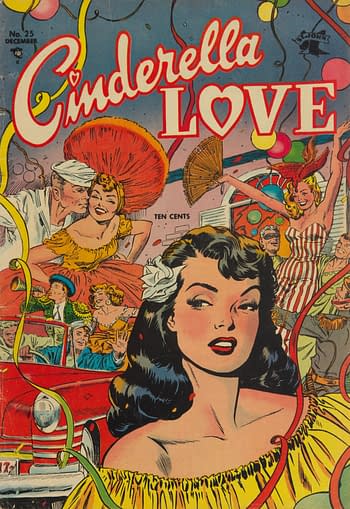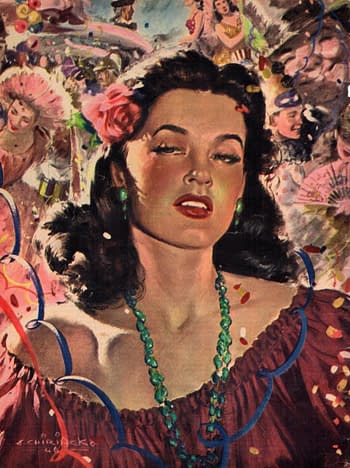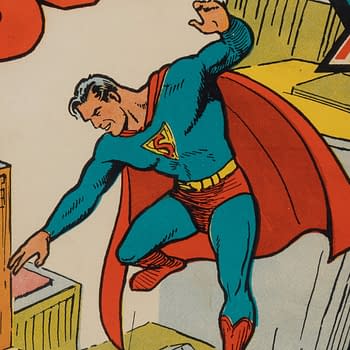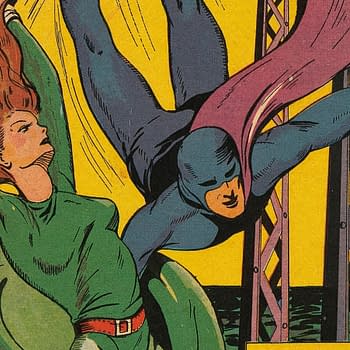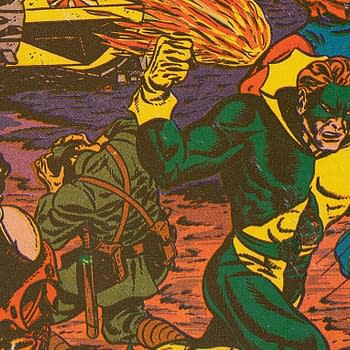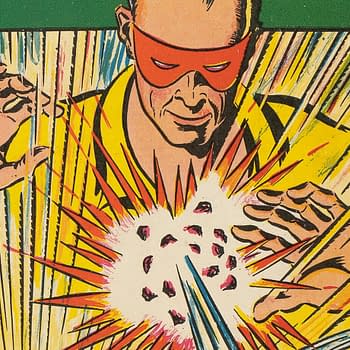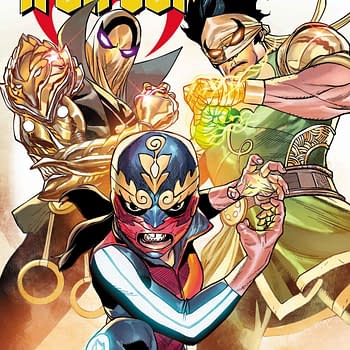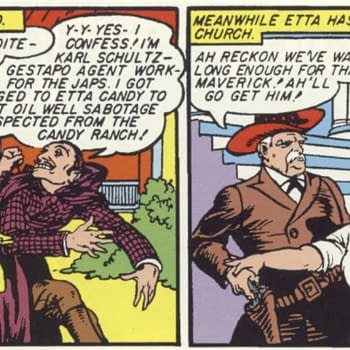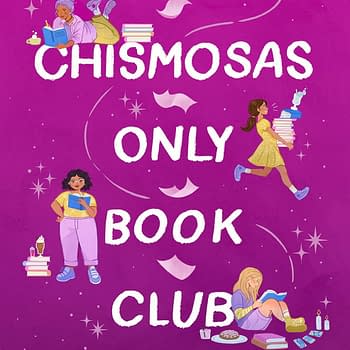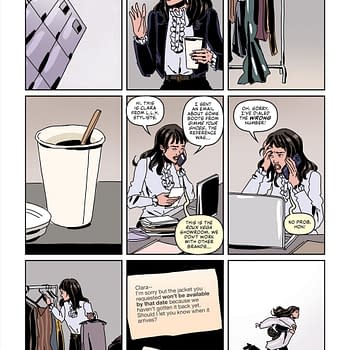Posted in: Comics, Heritage Sponsored, Vintage Paper | Tagged: Matt Baker, romance, St. John Publications
Secret Origin of Matt Baker's Cinderella Love #25 Cover, at Auction
The cover of Cinderella Love #25 is one Matt Baker's most famous covers, and its inspiration in a 1947 Liberty Magazine has a story to tell.
Article Summary
- Explore Matt Baker's cover art for Cinderella Love #25 and its collector allure.
- Uncover the 1947 Liberty Magazine piece that inspired Baker's work.
- Investigate the Greek magazine Thisavrós and its connection to this mystery.
- Delve into the art of referencing in comic book history.
Matt Baker's cover for Cinderella Love #25 (St. John, cover-dated December 1954) is considered among his best pieces of cover artwork, and it's easy to see why. A festive, celebratory theme, a budding romance in the background, and a beautiful woman in the foreground who clearly has something on her mind. Like much of Baker's artwork, it's a cover with a story to tell, and with those party streamers raining down, it feels like love is in the air here indeed. This issue has become one of the most sought-after romance comics and is near the top of most Baker collectors' lists as well. In June 2024, a CGC 7.5 copy sold for an incredible $60,000. The highest graded copy on the CGC Census as of this writing is a CGC 8.0 and copies of this issue don't change hands very often in any grade. In recent years, the story behind this comic book romance cover has started to materialize and has finally been revealed. The image was largely inspired by a painted illustration in Liberty Magazine volume 24 #1, January 4, 1947 by artist Ernest Chiriacka. There's a copy up for auction in the 2024 July 18 The Matt Baker Comics Showcase Auction #40267 at Heritage Auctions.
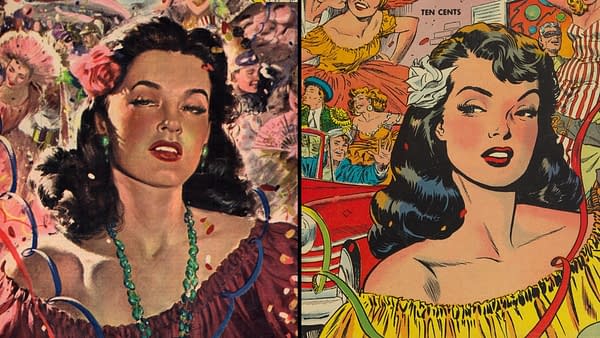
Comic book fan and historian interest in this famous Baker cover has surfaced some interesting surprises in recent years. In 2020, a copy of the February 20, 1949 issue #534 of the Greek magazine Θησαυρός (in romanized form: Thisavrós, which translates to "treasure") emerged which features artwork with several noteworthy elements that are clearly very similar to Baker's Cinderella Love #25 cover from over five years later. It's a fairly obvious swipe, which in and of itself is not a shock. Throughout comics history, it's certainly not an uncommon practice in varying degrees, and Baker was known to keep an extensive reference file. As noted by Fred Robinson, Baker's half-brother, when interviewed for the indispensable reference, Matt Baker: The Art of Glamour:
Oh, yeah, he had a tremendous swipe file, and he was a voracious collector of reference material. He would go through magazines and cut or tear out pages, and he really had quite an extensive file of it, categorized and everything. If he needed reference, all he had to do was open up his file, and he could go right to it.
A copy of Thisavrós #534 sold on eBay in March 2021 for an astonishing $1525.00, which would certainly seem to serve as confirmation of the power, allure, and popularity of the Cinderella Love #25 cover that the original source of this image helped inspire.
But the existence of this cover image brought up some obvious questions in a few corners of the internet: if this was Baker's inspiration for the Cinderella Love #25 cover artwork, where did he happen to see a copy of this Greek magazine? And who was the artist? There have been three magazine series named Thisavrós published in Greece, the most famous and historically important ran weekly from 1938 to 1967 for 1482 issues from publisher I. G. Papageorgiou, according to the Greek Comics forum, which appears to be the most authoritative source on the subject. The magazine was a mix of news, entertainment, fiction, and comics.
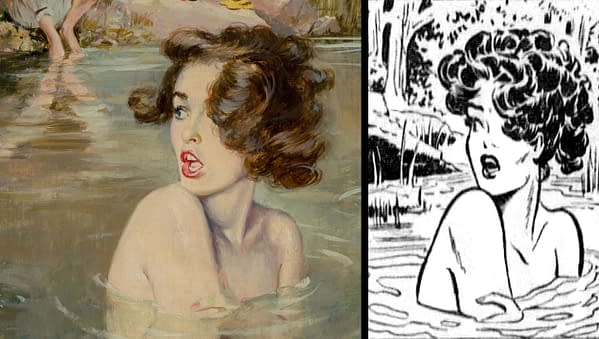
A second apparent swipe then surfaced involving a panel from an installment of the Flamingo comic strip created by Baker and Ruth Roche, published on July 3, 1952, and the cover of Thisavrós #710 from July 6, 1952. But the original version of that image was painted by Coby Whitmore for the story The Lady and the Tramp by Laurence Critchell in the April 26, 1952 issue of The Saturday Evening Post. Given the popularity of The Saturday Evening Post and a prior release date that seems well-timed to have inspired both Baker and the unknown artist of Thisavrós #710 for their early-July releases, it seems clear that Baker's source of inspiration was a publication he could've picked up on a newsstand in any number of places (note: Baker lived and worked in Mexico for a while during this period, though precise dates of his stay there are unknown). The scene painted by Whitmore is described in the first few paragraphs of Critchell's story, which is a setup that is somewhat similar to the lead-in for that moment in the Flamingo storyline.
And perhaps unsurprisingly, we now know that the imagery that appears on the cover of Thisavrós #534 in 1949 and Cinderella Love #25 in 1954 also has its origin in the pages of a popular mainstream American magazine — in this case, an issue of Liberty Magazine from 1947. The Thisavrós #534 cover appears to be a well-executed copy of the Liberty Magazine version, perhaps simply a copy of the original printed image touched up to make it suitable for reproduction.
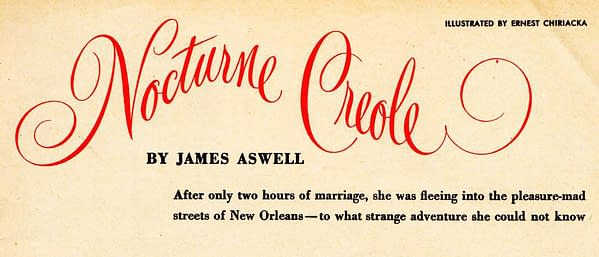
The original version of this image was created by painter Ernest Chiriacka for Liberty Magazine volume 24 #1, January 4, 1947, accompanying a story by author James Aswell called Nocturne Creole. As Chiriacka's painting implies, the story is a tale of romance and drama set in New Orleans during Mardi Gras:
New Orleans seemed to rock gently to the orgiastic pulse of Mardi Gras. Above the bumbling crowds, above the rosy fog of the flares, above King Zulu grandiosely drunk in bis jungle paint, above the rowdy débutantes on the Float of the Seven Sins, above the sad dark wind that was blowing a storm of confetti hearts down Canal Street—above all this and much, much more—things were happening in a hotel room.
They weren't original things. A boy and a girl had been married that afternoon and had begun to quarrel. Over nothing and over all the important things—how this character Pierre had come over to their table in Larabie's and she had been too nice to him. As little as that—and as much.
St. John Publications acquired the title Cinderella Love (along with the titles Romantic Love, Kid Cowboy and Wild Boy of the Congo) from publisher Ziff Davis, and the title contained reprints of the Ziff Davis material and earlier St John romance titles. It appears that Baker was sometimes loosely inspired for his covers on Cinderella Love by the interior stories. His cover for Cinderella Love #15 seems inspired by the interior story The Wall of Wealth, and his cover for Cinderella Love #26 is based on the interior story Dreams and Deceptions, for example.
But it appears that scheduling mistakes or changes sometimes happened (or perhaps they simply didn't care all that much). The cover of Cinderella Love #29 appears to match a scene from the story I was a Campus Tramp from issue #28, the previous issue. And it has been noted that the cover of Cinderella Love #25 seems to have the same theme as the story Mardi Gras Sweatheart from issue #26, the next issue.
Given that Ernest Chiriacka's image from Liberty Magazine volume 24 #1 was also for a Mardi Gras story, this seems likely. And all of this would also seem to confirm assertions by Fred Robinson and others that Baker had an extensive — and more to the point — a well-organized and categorized reference file. When Baker wanted a reference for a woman bathing in a stream being interrupted by a man, he found one. When he wanted a reference for a Mardi Gras romance, he found exactly that as well.
The market's reaction to the emergence of Thisavrós #534 was in itself an interesting commentary on the notion of reference and swiping. Even though it now seems unlikely Baker ever saw the Thisavrós issue, the idea that this obscure publication sold for $1525.00 on the basis of it being a prior version of Baker's famous cover imagery seems to confirm the stature of his well-executed cover as continuing to be an important part of his legacy. It may also be worth noting that the Facebook group Comic Swipes has assembled an absolutely incredible number of examples of swipes involving historically important material and artists.
Such historical comparisons also give one an appreciation for the artists who inspired sometimes well-known comic book material. Chiriacka was a prolific cover and interior artist across a wide range of pulps and slick magazines, ranging from Black Book Detective and Detective Fiction Weekly to Colliers, Esquire, and The Saturday Evening Post among countless others. Perhaps relevant to this discussion given the Thisavrós connection, Chiriacka was of Greek ancestry, his parents having moved from Greece to New York City in 1907. Did this image catch the eye of the editors of Thisavrós because of some awareness of his work? Certainly, it seems apparent that they used a wide variety of sources during this period. Regardless of all this, an examination of Chiriacka's work is well worth your time.
And if you're a Baker collector or even a fan of classic magazine or pulp illustration like Chiriacka's work, Liberty Magazine volume 24 #1, January 4, 1947 is a good place to start, and a copy of this issue has sold for $1810 in recent times. The inspiration for one of Matt Baker's most famous covers and now highly sought after by Baker collectors in its own right in the time since this article was originally posted in July 2022, there's a copy of Liberty Magazine volume 24 #1, January 4, 1947 up for auction in the 2024 July 18 The Matt Baker Comics Showcase Auction #40267 at Heritage Auctions.
- Cinderella Love #25, St. John, 1954), cover by Matt Baker.
- Painted illustration by Ernest Chiriacka for Liberty Magazine volume 24 #1 Liberty Magazine, Inc, January 4, 1947).



